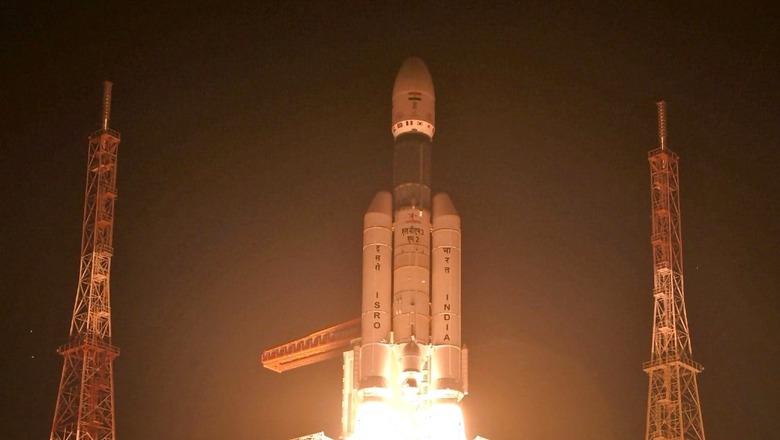
views
The Indian Space Research Organisation (ISRO) successfully dived into the global space market of heavy payloads on Saturday night with the maiden commercial launch of its gigantic rocket – LVM-3 from the GSLV series.
India’s heaviest launcher ascended 601 km into space from Sriharikota precisely at 12:07 am and precisely injected all the 36 satellites in their intended orbits during the next 1.15 hour, in its first-ever multi-satellite launch. All the satellites are now functional and in contact with the ground stations, confirmed OneWeb.
ISRO chairman S Somanath termed the mission ‘historic’ – one that would open up the space market for LVM-3 which has already undertaken four launches including Chandrayaan-2 in 2019. It is also undergoing human testing for India’s most ambitious space mission – Gaganyaan. Unlike ISRO’s powerhorse – PSLV, the new rocket from the GSLV series can carry up to 8,000 kg payload – the highest so far for any Indian rocket.
PAVES WAY FOR MORE COMMERCIAL LAUNCHES
With its biggest commercial deal so far, the space agency has taken the “next big step in the right direction”, say experts, highlighting that it will help establish India as a partner for launching heavier satellites into the low-earth orbit (LEO), especially for a cost-effective delivery.
“Over the years, ISRO has proven its capability in launching foreign satellites in LEO. It is a game that the space agency has already mastered. But most of them were micro or nano-satellites. With this mission, we have shown that we can carry heavier payloads too in a cost-effective manner, and that market for communications and broadband satellites is growing rapidly,” says Gp Capt (retd) Ajey Lele, consultant at Manohar Parrikar Institute for Defence Studies and Analyses, New Delhi. “ISRO has taken the right step, at the right time.”
The space agency has already launched as many as 345 foreign satellites so far in multiple missions on its most reliable rocket – the PSLV. One of the biggest such launch was in 2017, when it lifted off as many as 104 satellites in one go, out of which 103 were international satellites belonged to the US, Netherlands, Switzerland, Israel, Kazakhstan and the UAE.
COMPLEX MISSION
What made the mission complex and unique for ISRO was that it demanded that all 36 satellites weighing about 145 kg each get separated from the rocket in a proper sequence of nine phases, such that each pair of satellite is at a distance of at least 137 metres away from each other. OneWeb is building a constellation of 588 satellites in the earth’s LEO – with 49 satellites placed in 12 rings.
For this, the agency had to orient and re-orient its cryogenic stages through the on board thrusters to achieve the intended separation. This is also the reason that the mission took almost 1.5 hour from the launch to achieve its final goal. ISRO also had to modify its payload adaptor to be compatible with OneWeb’s satellite dispenser.
INSTILLS CONFIDENCE IN LVM-3
The rocket used for the mission is also the same which is being readied for ISRO’s most ambitious spaceflight till date – Gaganyaan. It is currently undergoing the process of human rating, and each successful launch helps in building more confidence, said ISRO scientists.
“We had to ensure that each batch of satellite is injected precisely into the low earth orbit so that they do not collide with each other during separation. There was also a strict requirement of maintaining a minimum distance between the two satellites at any point in time. This requires pointing the rocket in a certain direction, sudden manoeuvres once it is in space and maintaining an incremental velocity. All this requires precision,” said Dr R Sam Dayala Dev, Director oF ISRO’s Inertial Systems Unit.
FIRST COMMERCIAL LAUNCH WITH ONEWEB
It was also NewSpace India (NSIL)’s first commercial partnership with the UK-based OneWeb which plans to build a global communications network with its first constellation of 648 satellites in space by 2023. With four more launches to go, it will be ready to achieve its target of high-speed, low-latency connectivity worldwide by 2023.
“It is truly red-letter day for India, for NSIL as well as for OneWeb as we embark on the 14th launch. I am glad that we lifted off one of the most important missions from India through the GSLV-3 (designate as LVM-3),” said Sunil Bharti Mittal, founder and chairman, Bharti Enterprises, who is major investor and shareholder in the company.
ISRO’s commercial arm, NSIL which has been working to amp up the business opportunities for India in the global space market hailed the launch as an extremely significant milestone. “It would open the big market for the heavy launcher especially at a time when many big operators want to build satellites in LEO as part of constellation to meet global communication network. This step will go a long way in expanding India’s market share in global space economy,” said NSIL chairman D Radhakrishnan, adding that the milestone was achieved in a record time of few months.
Read all the Latest India News here


















Comments
0 comment